Rick Just's Blog, page 136
February 7, 2021
Is that a Watergate Behind Them?
The Railroad Ranch, which would become Harriman State Park, had many well-known visitors over the years. This was late in the history of the ranch. On the left is Steve Bly, who was the Idaho Department of Parks and Recreation director in 1974 when the picture was taken. The fish belongs to Elliot Richardson. He was US attorney general during the Nixon and Ford Administration. He famously resigned rather than fire special prosecutor Archibald Cox on Nixon’s order during the Watergate scandal.
Former Idaho Congressman Walt Minnick, who at the time was serving in the Nixon administration, also resigned in protest.
By the way, fishing is no longer allowed in Silver and Golden lakes within the park. You can fish in Millionaires Hole on the Henrys Fork as it winds in front of the ranch compound. You can’t keep those trophy trout, though. It’s catch and release only.

Former Idaho Congressman Walt Minnick, who at the time was serving in the Nixon administration, also resigned in protest.
By the way, fishing is no longer allowed in Silver and Golden lakes within the park. You can fish in Millionaires Hole on the Henrys Fork as it winds in front of the ranch compound. You can’t keep those trophy trout, though. It’s catch and release only.

Published on February 07, 2021 04:00
February 6, 2021
The 1916 Elevator Crash
Let’s just admit it, the elevators in Idaho’s Statehouse have always been a little quirky. On January 8, 1917 it was a laughing matter when an elevator cable broke. There were only two people in the car at the time, operator John W. Ewry, and an unidentified man who was not an elected official. The two men heard the cable snap when the door was open and they were able to jump out on the third floor before the car fell. It only fell about 12 feet, so mayhem may not have resulted in any case.
The Republicans in the Legislature were quick to point out that the elevator had worked perfectly when they were in control of the Legislature. The Ds had just taken control in the 1916 election. The Democrats responded that the Republicans had simply worn the thing out.
Such were the ups and downs of politics in 1916.
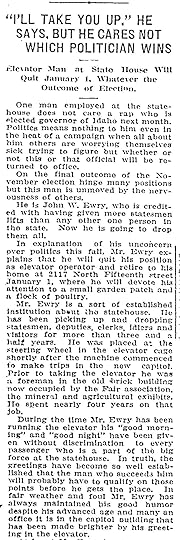
The Republicans in the Legislature were quick to point out that the elevator had worked perfectly when they were in control of the Legislature. The Ds had just taken control in the 1916 election. The Democrats responded that the Republicans had simply worn the thing out.
Such were the ups and downs of politics in 1916.

Published on February 06, 2021 04:00
February 5, 2021
The Idaho Salt Wells Post Card
It’s ephemera month at Speaking of Idaho. I’m writing a few little blurbs about some interesting ephemera I’ve collected over the years. Often there’s little or no historic value to the pieces, but each one tells a story.
This little card, and others like it, came with one-pound sacks of Arbuckle’s Ariosa Coffee. The company is still in existence. Here’s a history blurb from their website:
“Arbuckles’ Coffee began in the post Civil War Era of the 19th Century. Two brothers, John and Charles Arbuckle, initiated a new concept in the coffee industry; selling roasted coffee in one pound packages. Until that time, coffee was sold green and had to be roasted in a skillet over a fire or in a wood stove. You can imagine the inconsistency of the coffee. One burned bean ruined the whole batch. The Arbuckle Brothers were able to roast a coffee that was of consistently fine quality and the first to be packaged in one pound bags.
“Arbuckles’ Ariosa Blend became so popular in the Old West that most cowboys didn't even know that there was any other. Arbuckles’ Coffee was prominent in such infamous cow towns as Dodge City and Tombstone. To many of the older cowboys, Arbuckles’ Ariosa Blend is still known as the Original Cowboy Coffee.”
The trading cards (collect them all!) featured 50 states and territories. Today, an Idaho card would likely feature potatoes. In the 1860s, the cards featured that amazing Idaho product, salt. If you didn’t know about Idaho’s salt production, check this blog post I wrote about it.
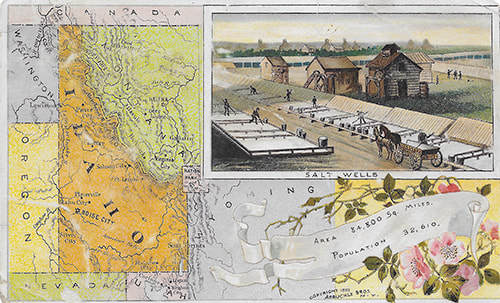 The front of the coffee card.
The front of the coffee card.  Coffee card back.
Coffee card back.
This little card, and others like it, came with one-pound sacks of Arbuckle’s Ariosa Coffee. The company is still in existence. Here’s a history blurb from their website:
“Arbuckles’ Coffee began in the post Civil War Era of the 19th Century. Two brothers, John and Charles Arbuckle, initiated a new concept in the coffee industry; selling roasted coffee in one pound packages. Until that time, coffee was sold green and had to be roasted in a skillet over a fire or in a wood stove. You can imagine the inconsistency of the coffee. One burned bean ruined the whole batch. The Arbuckle Brothers were able to roast a coffee that was of consistently fine quality and the first to be packaged in one pound bags.
“Arbuckles’ Ariosa Blend became so popular in the Old West that most cowboys didn't even know that there was any other. Arbuckles’ Coffee was prominent in such infamous cow towns as Dodge City and Tombstone. To many of the older cowboys, Arbuckles’ Ariosa Blend is still known as the Original Cowboy Coffee.”
The trading cards (collect them all!) featured 50 states and territories. Today, an Idaho card would likely feature potatoes. In the 1860s, the cards featured that amazing Idaho product, salt. If you didn’t know about Idaho’s salt production, check this blog post I wrote about it.
 The front of the coffee card.
The front of the coffee card.  Coffee card back.
Coffee card back.
Published on February 05, 2021 04:00
February 4, 2021
2B or not 2B
2B or not 2B—that is the question: Whether ‘tis nobler to be from Bear Lake County or one of Idaho’s 43 other counties.
Since 1945 Idahoans could tell where most cars are registered simply by looking at their license plates. It’s handy if you want to grouse about the “Great State of Ada,” or that BMW from Sun Valley, or that clueless driver yet to find his or her turn signal switch from, say, Canyon County (just to pick one at random).
The way it works, in case you just moved here from California (to pick a state at random), is that the letter stands for the first letter in the county, and the number refers to where that county would rank in an alphabetical list. For instance, 1B is from Bannock County and 2B is from Bear Lake County.
Learning the county designators, and thus the counties has been a great game for road-weary kids for generations. Then, along came personalized and specialty plates. Neither carries a county designator, so if you want to go incognito you can get a personalized plate such as GOFISH. It’ll cost you a little extra. Also, you could show your affinity for some activity, group, or whatever by getting a specialty plate.
Legislators have mucked around with limits on how many kinds of specialty plates are allowed several times. They seem to have given up on limits nowadays if you can find enough friends who also want a plate that shows their affinity for horned toads or counted cross-stitch. The plates must sell X number a year (also a moving target in any given legislative year) for two years. The last time I checked there were more than 70 specialty plates available. If you want your specialty Corvette plate to read 2RICH, you can do that. Specialty plates can have a personal message.
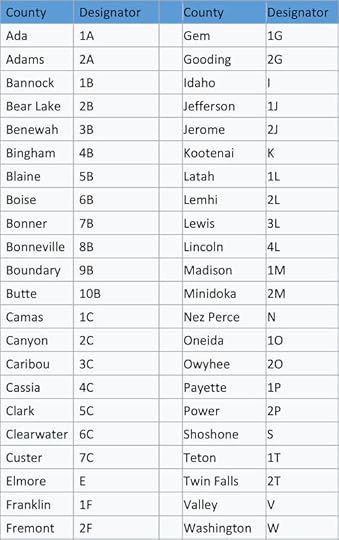
Since 1945 Idahoans could tell where most cars are registered simply by looking at their license plates. It’s handy if you want to grouse about the “Great State of Ada,” or that BMW from Sun Valley, or that clueless driver yet to find his or her turn signal switch from, say, Canyon County (just to pick one at random).
The way it works, in case you just moved here from California (to pick a state at random), is that the letter stands for the first letter in the county, and the number refers to where that county would rank in an alphabetical list. For instance, 1B is from Bannock County and 2B is from Bear Lake County.
Learning the county designators, and thus the counties has been a great game for road-weary kids for generations. Then, along came personalized and specialty plates. Neither carries a county designator, so if you want to go incognito you can get a personalized plate such as GOFISH. It’ll cost you a little extra. Also, you could show your affinity for some activity, group, or whatever by getting a specialty plate.
Legislators have mucked around with limits on how many kinds of specialty plates are allowed several times. They seem to have given up on limits nowadays if you can find enough friends who also want a plate that shows their affinity for horned toads or counted cross-stitch. The plates must sell X number a year (also a moving target in any given legislative year) for two years. The last time I checked there were more than 70 specialty plates available. If you want your specialty Corvette plate to read 2RICH, you can do that. Specialty plates can have a personal message.

Published on February 04, 2021 04:00
February 3, 2021
Idaho Coal
Coal is not a popular mineral in these days of climate change. But states where an abundance of it was found gained some prosperity for many years. Not Idaho, of course. No coal in Idaho. Or, as the Idaho Museum of Natural History states on their website, “Almost every important mineral except oil, gas and coal can be found in Idaho.”
Some would beg to differ. “A few thin beds” of coal have been found north of Horseshoe Bend and in the surrounding area. Also, geologists have found some coal near the Utah border in Cassia County. None of that amounts to much. But, how does 11 million tons sound? That’s the estimated amount of coal in several seams in the Horseshoe Basin near Driggs.
A small mine operated there beginning in 1905, but it was 1921 when things really got going with the development of a branch railroad to the Brown Bear seam where the Gem State Coal Company began working on a tunnel. By the following year the tunnel went 650 feet into the seam and coal had been shipped to nearby communities in Montana and Idaho. They mined into the 1930s, but a declining market for coal killed the operation. Most of that 11 million tons is still in the ground where, with the cost of other energy sources undercutting it, the coal will likely remain.
On a personal note, in 1924 my father-in-law was born in Sam, Idaho (long since abandoned) where his father was working for the Gem State Coal company.

Some would beg to differ. “A few thin beds” of coal have been found north of Horseshoe Bend and in the surrounding area. Also, geologists have found some coal near the Utah border in Cassia County. None of that amounts to much. But, how does 11 million tons sound? That’s the estimated amount of coal in several seams in the Horseshoe Basin near Driggs.
A small mine operated there beginning in 1905, but it was 1921 when things really got going with the development of a branch railroad to the Brown Bear seam where the Gem State Coal Company began working on a tunnel. By the following year the tunnel went 650 feet into the seam and coal had been shipped to nearby communities in Montana and Idaho. They mined into the 1930s, but a declining market for coal killed the operation. Most of that 11 million tons is still in the ground where, with the cost of other energy sources undercutting it, the coal will likely remain.
On a personal note, in 1924 my father-in-law was born in Sam, Idaho (long since abandoned) where his father was working for the Gem State Coal company.

Published on February 03, 2021 04:00
February 2, 2021
First Day Issue
It’s ephemera month at Speaking of Idaho. I’m writing a few little blurbs about some interesting ephemera I’ve collected over the years. Often there’s little or no historic value to the pieces, but each one tells a story.
Yesterday I featured some stamps that have been produced about Idaho over the years. In today's follow-up, here are a couple of First Day Issue envelopes you might find interesting.
The first one is from 1940, the 50th anniversary of Idaho statehood. The stamp depicts Idaho’s statehouse and the First Day Issue envelope depicts a miner and his mule.
The second, from 50 years later, celebrates the state’s Centennial. Idaho’s state bird, the Mountain Bluebird is featured on the stamp.
This Bluebird cover was made unique by Mark D. Grabowski, an artist who specialized in painting little scenes on First Day of Issue envelopes. FYI, his envelopes sell for anywhere from $15 to $150 today, depending on rarity. I’m not sure what they sold for at the time of their creation.
According to our brainy friends at Wikipedia, “A first day of issue cover or first day cover (FDC) is a postage stamp on a cover, postal card or stamped envelope franked on the first day the issue is authorized for use[1] within the country or territory of the stamp-issuing authority. Sometimes the issue is made from a temporary or permanent foreign or overseas office. Covers that are postmarked at sea or their next port of call will carry a Paquebot postmark.[2] There will usually be a first day of issue postmark, frequently a pictorial cancellation, indicating the city and date where the item was first issued, and "first day of issue" is often used to refer to this postmark. Depending on the policy of the nation issuing the stamp, official first day postmarks may sometimes be applied to covers weeks or months after the date indicated.
Postal authorities may hold a first day ceremony to generate publicity for the new issue, with postal officials revealing the stamp, and with connected persons in attendance, such as descendants of the person being honored by the stamp. The ceremony may also be held in a location that has a special connection with the stamp's subject, such as the birthplace of a social movement, or at a stamp show.”
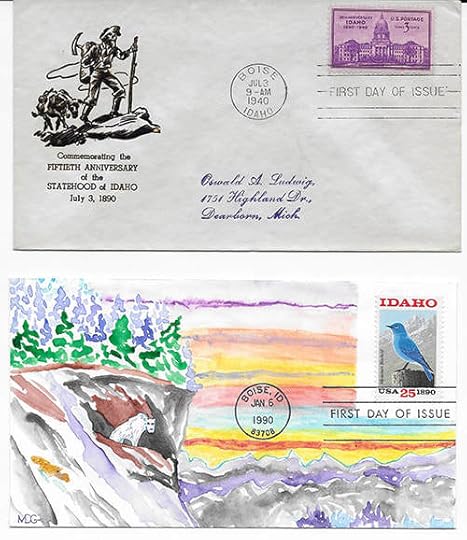
Yesterday I featured some stamps that have been produced about Idaho over the years. In today's follow-up, here are a couple of First Day Issue envelopes you might find interesting.
The first one is from 1940, the 50th anniversary of Idaho statehood. The stamp depicts Idaho’s statehouse and the First Day Issue envelope depicts a miner and his mule.
The second, from 50 years later, celebrates the state’s Centennial. Idaho’s state bird, the Mountain Bluebird is featured on the stamp.
This Bluebird cover was made unique by Mark D. Grabowski, an artist who specialized in painting little scenes on First Day of Issue envelopes. FYI, his envelopes sell for anywhere from $15 to $150 today, depending on rarity. I’m not sure what they sold for at the time of their creation.
According to our brainy friends at Wikipedia, “A first day of issue cover or first day cover (FDC) is a postage stamp on a cover, postal card or stamped envelope franked on the first day the issue is authorized for use[1] within the country or territory of the stamp-issuing authority. Sometimes the issue is made from a temporary or permanent foreign or overseas office. Covers that are postmarked at sea or their next port of call will carry a Paquebot postmark.[2] There will usually be a first day of issue postmark, frequently a pictorial cancellation, indicating the city and date where the item was first issued, and "first day of issue" is often used to refer to this postmark. Depending on the policy of the nation issuing the stamp, official first day postmarks may sometimes be applied to covers weeks or months after the date indicated.
Postal authorities may hold a first day ceremony to generate publicity for the new issue, with postal officials revealing the stamp, and with connected persons in attendance, such as descendants of the person being honored by the stamp. The ceremony may also be held in a location that has a special connection with the stamp's subject, such as the birthplace of a social movement, or at a stamp show.”

Published on February 02, 2021 04:00
February 1, 2021
Idaho in the Mail
It’s ephemera month at Speaking of Idaho. I’m writing a few little blurbs about some interesting ephemera I’ve collected over the years. Often there’s little or no historic value to the pieces, but each one tells a story.
I've collected several postage stamps honoring Idaho over the years. The rarer they are, the better. Collectors prefer unused stamps are, and an unused sheet of stamps is even better. Here are a few you might enjoy. If you know of other Idaho stamps, please post a picture in the comments.
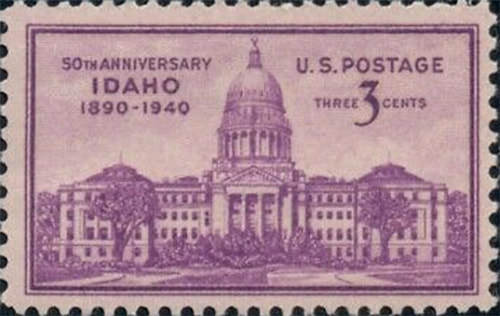 A 1940 stamp celebrating the 50th Anniversary of Idaho Statehood.
A 1940 stamp celebrating the 50th Anniversary of Idaho Statehood. 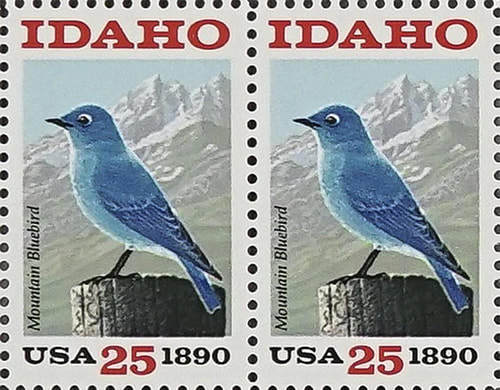 The 1990 Idaho Centennial stamp featured a mountain bluebird, one of our state symbols.
The 1990 Idaho Centennial stamp featured a mountain bluebird, one of our state symbols. 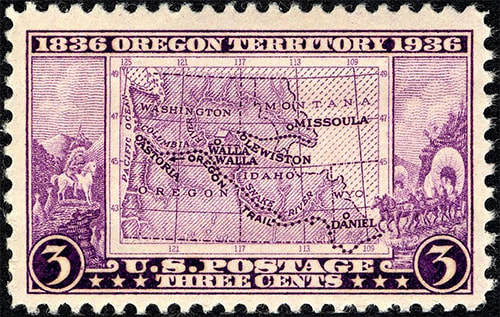 In 1936 the US Post Office issued a stamp celebrating the Oregon Territory Centennial.
In 1936 the US Post Office issued a stamp celebrating the Oregon Territory Centennial. 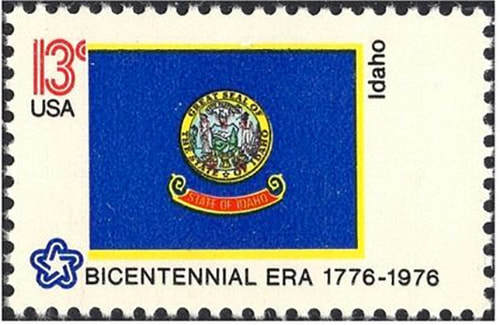 During the country's Bicentennial USPS issued stamps featuring the flags of each state.
During the country's Bicentennial USPS issued stamps featuring the flags of each state. 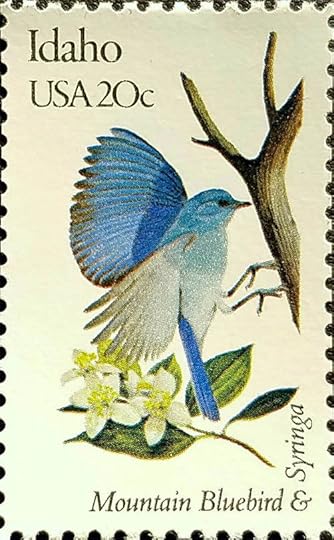 The Idaho Centennial stamp wasn't the first to feature our state bird. This 1982 stamp had two state symbols, the mountain bluebird and the syringa.
The Idaho Centennial stamp wasn't the first to feature our state bird. This 1982 stamp had two state symbols, the mountain bluebird and the syringa. 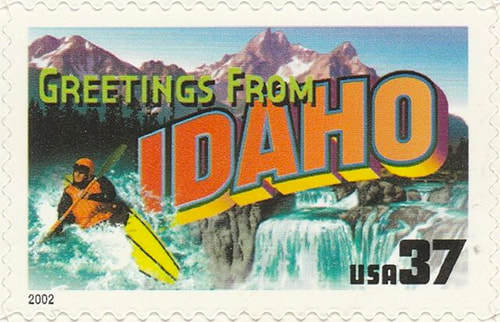 In 2002 the Post Office created a series of tourism stamps featuring each state.
In 2002 the Post Office created a series of tourism stamps featuring each state.
I've collected several postage stamps honoring Idaho over the years. The rarer they are, the better. Collectors prefer unused stamps are, and an unused sheet of stamps is even better. Here are a few you might enjoy. If you know of other Idaho stamps, please post a picture in the comments.
 A 1940 stamp celebrating the 50th Anniversary of Idaho Statehood.
A 1940 stamp celebrating the 50th Anniversary of Idaho Statehood.  The 1990 Idaho Centennial stamp featured a mountain bluebird, one of our state symbols.
The 1990 Idaho Centennial stamp featured a mountain bluebird, one of our state symbols.  In 1936 the US Post Office issued a stamp celebrating the Oregon Territory Centennial.
In 1936 the US Post Office issued a stamp celebrating the Oregon Territory Centennial.  During the country's Bicentennial USPS issued stamps featuring the flags of each state.
During the country's Bicentennial USPS issued stamps featuring the flags of each state.  The Idaho Centennial stamp wasn't the first to feature our state bird. This 1982 stamp had two state symbols, the mountain bluebird and the syringa.
The Idaho Centennial stamp wasn't the first to feature our state bird. This 1982 stamp had two state symbols, the mountain bluebird and the syringa.  In 2002 the Post Office created a series of tourism stamps featuring each state.
In 2002 the Post Office created a series of tourism stamps featuring each state.
Published on February 01, 2021 04:00
January 31, 2021
Pop Quiz!
Below is a little Idaho trivia quiz. If you’ve been following Speaking of Idaho, you might do very well. Caution, it is my job to throw you off the scent. Answers below the picture. If you missed that story, click the letter for a link.
1). What Idaho writer penned the screenplay for the movie Northwest Passage?
A. Ernest Hemmingway.
B. Vardis Fisher.
C. Talbot Jennings.
D. Carol Ryrie Brinks.
E. Grace Jordan.
2). What made the 1948 Idaho license plate unique?
A. It was the first to feature a baked potato.
B. It was the first to feature a decal.
C. That was the first year they made plates at the prison.
D. It was the first year the slogan WORLD FAMOUS POTATOES was used on a license plate.
E. All of the above.
3). What amazing thing was found in a Malad Gorge cave?
A. Horse fossils.
B. Stagecoach loot.
C. A unique salamander.
D. Horse hoofprints.
E. Cached gear from the Wilson Price Hunt expedition.
4). What building is the skyscraper sculpture in Boise supposed to represent?
A. The Empire State Building
B. The Hoff Building.
C. The Hotel Boise.
D. The Chrysler Building.
E. None.
5) Why doesn’t the swinging bridge in Heyburn State Park move anymore?
A. There are no longer steamboats on the lake.
B. It is rusted shut.
C. It was permanently lifted high enough for boats to pass beneath.
D. The railroad tracks and bridge were removed.
E. It was reconfigured so that it is now a drawbridge.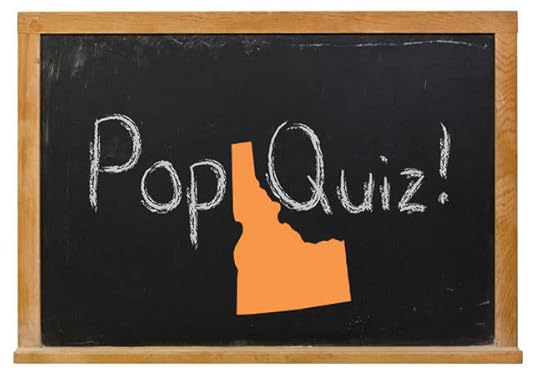 Answers (If you missed that story, click the letter for a link)
Answers (If you missed that story, click the letter for a link)
1, C
2, E
3, D
4, E
5, C
How did you do?
5 right—Why aren’t you writing this blog?
4 right—A true Idaho native, no matter where you’re from.
3 right—Good! Treat yourself to some French fries.
2 right—Okay! Eat more potatoes!
1 right—Meh. You need to read more blog posts.
0 right—Really, you should reconsider your recent relocation.
1). What Idaho writer penned the screenplay for the movie Northwest Passage?
A. Ernest Hemmingway.
B. Vardis Fisher.
C. Talbot Jennings.
D. Carol Ryrie Brinks.
E. Grace Jordan.
2). What made the 1948 Idaho license plate unique?
A. It was the first to feature a baked potato.
B. It was the first to feature a decal.
C. That was the first year they made plates at the prison.
D. It was the first year the slogan WORLD FAMOUS POTATOES was used on a license plate.
E. All of the above.
3). What amazing thing was found in a Malad Gorge cave?
A. Horse fossils.
B. Stagecoach loot.
C. A unique salamander.
D. Horse hoofprints.
E. Cached gear from the Wilson Price Hunt expedition.
4). What building is the skyscraper sculpture in Boise supposed to represent?
A. The Empire State Building
B. The Hoff Building.
C. The Hotel Boise.
D. The Chrysler Building.
E. None.
5) Why doesn’t the swinging bridge in Heyburn State Park move anymore?
A. There are no longer steamboats on the lake.
B. It is rusted shut.
C. It was permanently lifted high enough for boats to pass beneath.
D. The railroad tracks and bridge were removed.
E. It was reconfigured so that it is now a drawbridge.
 Answers (If you missed that story, click the letter for a link)
Answers (If you missed that story, click the letter for a link)1, C
2, E
3, D
4, E
5, C
How did you do?
5 right—Why aren’t you writing this blog?
4 right—A true Idaho native, no matter where you’re from.
3 right—Good! Treat yourself to some French fries.
2 right—Okay! Eat more potatoes!
1 right—Meh. You need to read more blog posts.
0 right—Really, you should reconsider your recent relocation.
Published on January 31, 2021 04:00
January 30, 2021
The Swinging Bridge
Picnickers from Spokane used to take a train to Coeur d’Alene, then catch a paddlewheel steamboat to Heyburn State Park in the early part of the 20th Century. This shot on the left shows the swinging railroad bridge in action, letting a steamboat into the St. Joe River.
On the right is the same bridge today, though it doesn’t swing anymore. Engineers raised it high enough to let sailboats beneath it when Trail of the Coeur d’Alenes was built in about 2004. The 72-mile trail goes from Plummer to Mullan on the old railroad bed. It’s paved all the way, including this section that goes across the lake and the old swinging bridge in Heyburn State Park.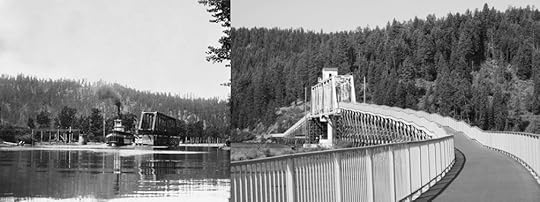
On the right is the same bridge today, though it doesn’t swing anymore. Engineers raised it high enough to let sailboats beneath it when Trail of the Coeur d’Alenes was built in about 2004. The 72-mile trail goes from Plummer to Mullan on the old railroad bed. It’s paved all the way, including this section that goes across the lake and the old swinging bridge in Heyburn State Park.

Published on January 30, 2021 04:00
January 29, 2021
Joe Albertson
When Joe Albertson started working for the Safeway chain of supermarkets, he may have dreamed of owning the store someday. In a sense, he ended up owning the store and the entire Safeway chain.
From the time he attended the College of Idaho, graduating in 1925, all Joe Albertson wanted was to be a grocer. He worked for Safeway, a chain that started in Idaho (as Skaggs, in American Falls), for several years, then borrowed $7,500 from his aunt and matched that with $5,000 of his own savings to start his own grocery store on State Street in Boise. That was in 1939. Joe added a store and another and another until he had a chain of Albertsons stores. It was a well-known brand throughout the West when he died in 1993.
Albertsons all but disappeared for a time after his death, but former employees of the company reorganized under the Albertsons name in 2006. The company is a now a retail giant.
Joe Albertson would be proud that the company he started now owns the company he first started to work for, Safeway. He was known for his generosity. The two best examples are his donation of Kathryn Albertson Park in Boise, and the Albertson Foundation, which still gives millions to Idaho projects, particularly in the field of education.
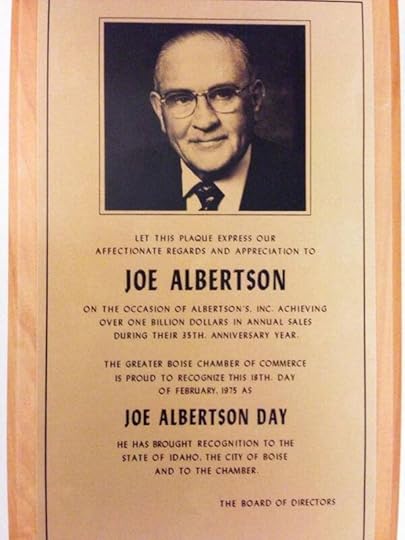
From the time he attended the College of Idaho, graduating in 1925, all Joe Albertson wanted was to be a grocer. He worked for Safeway, a chain that started in Idaho (as Skaggs, in American Falls), for several years, then borrowed $7,500 from his aunt and matched that with $5,000 of his own savings to start his own grocery store on State Street in Boise. That was in 1939. Joe added a store and another and another until he had a chain of Albertsons stores. It was a well-known brand throughout the West when he died in 1993.
Albertsons all but disappeared for a time after his death, but former employees of the company reorganized under the Albertsons name in 2006. The company is a now a retail giant.
Joe Albertson would be proud that the company he started now owns the company he first started to work for, Safeway. He was known for his generosity. The two best examples are his donation of Kathryn Albertson Park in Boise, and the Albertson Foundation, which still gives millions to Idaho projects, particularly in the field of education.

Published on January 29, 2021 04:00



